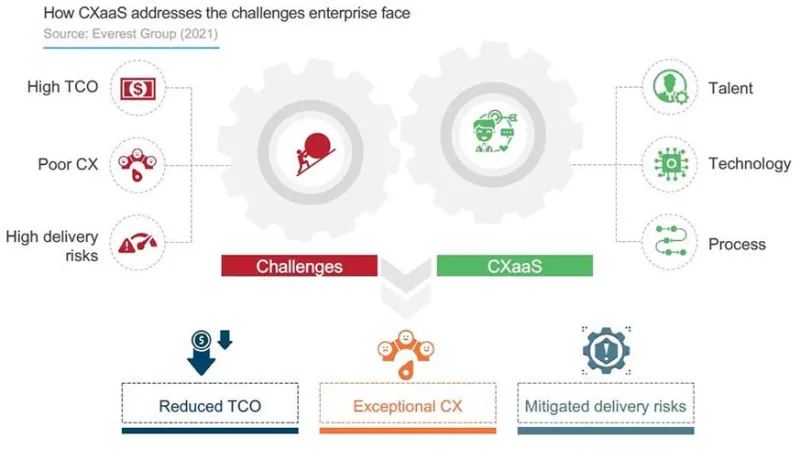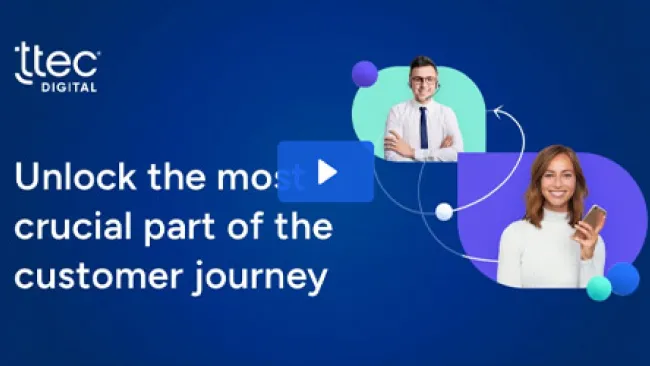The pandemic accelerated consumers’ shift to digital channels in ways no one could have foreseen, forcing businesses to catch up quickly or risk being left behind. But as we start to move beyond the pandemic, brands must grapple with the lasting effects of this digital surge. It’s no longer enough to have stop-gap measures in place; rather, brands must embrace longer-term transformation. The new normal is digital.
CXaaS is key to transforming
To truly realize the benefits digital transformation can generate, businesses must harness the power of Customer Experience as a Service (CXaaS). This end-to-end, holistic approach integrates digital capabilities – like artificial intelligence, cloud-based CX technology, and intelligent automation – into every phase of the customer and employee journeys, resulting in better experiences and bottom-line results.
It’s no secret that companies face various challenges: high total cost of ownership, poor CX, and high delivery risks. CXaaS overcomes these obstacles by putting the right mix of talent, technology and people to work. The results? Lower TCO, exceptional CX, and mitigated delivery risks.

Source: TTEC
CXaaS can reduce TCO in many ways, in both the near and long term. Among the immediate benefits, there is no cost to implement a CXaaS model—initial design and consulting costs fall on the service provider. There are also no up-front software, hardware, or infrastructure costs, as they’re included in the CXaaS model.
Over the long term, automating or eliminating certain tasks through CXaaS reduces contacts, which in turn decreases the total cost of support. This model also leads to more cohesive customer journeys and improved employee experience, which bolsters customers satisfaction and customer loyalty, in addition to bottom lines.
The business case for CXaaS is strong. But its benefits become exponentially more powerful when companies partner with the right service provider to take things to the next level. Each element of CXaaS – journey design, CX consulting, system integration, and new solutions – can deliver incremental gains when delivered by individual providers. But the “multiplier effect” of partnering with the right all-encompassing provider, one whose expertise envelopes journey orchestration and technology, can bring huge growth and return on investment to brands.
5 qualities every provider should have
Finding the right CXaaS provider is essential because it won’t merely be a delivery engine, it will be an enterprise partner. It’s imperative to have a trusted partner with a proven track record, that understands the stakes and has the expertise to deliver results.
In recent joint research, TTEC and Everest detailed some of the key characteristics to look for in a CXaaS partner.
Qualitative attributes. The right provider should be able to transition from a transactional relationship to joint governance, shifting from a delivery engine to an accomplice. A true partner will help take a company’s approach to the next level, moving it from a piecemeal model to one that unifies technology, talent and services into one cohesive solution.
When choosing a provider, make sure it shares the organization’s vision for CX transformation and will co-innovate with the business to create best-in-class solutions. CXaaS is a partnership.
Delivery footprint. Here, balance is key. Seek a partner with a balanced delivery footprint because having options and flexibility has never been so important. Having a diverse footprint also helps mitigate the risk of inflation in certain economies. An on-shore presence can help ensure great CX and strong cyber security, for instance, while a presence in off-shore regions can help keep wage-related expenses in check.
Also make sure any provider has flexible delivery model options, including ones that use work-from-home associates. Being agile enough to pivot when needed is critical.
Talent management. To get and retain best-in-class talent, a CXaaS provider should use digitally oriented talent management tools. Steer clear of ones that rely on manual techniques; they consume too much time, money and capacity that can be better spent elsewhere. A good partner will use tools like AI, automation and analytics.
Seek partners that use customized gamification, instructor-led coaching, or self-paced learning modules. These tools increase engagement, build skills, and lead to better employee performance.
Core contact center solutions. A cloud-based contact infrastructure is a must for any provider. This should include integrations with chat platforms, IVR, and other digital solutions. To ensure seamless transitions, look for platforms that integrate with other solutions, such as Workforce Management/Workforce Optimiztion, to improve staff planning, operational metrics, forecasting accuracy and associate utilization.
Automation and AI. AI solutions are incredibly valuable when it comes to improving associate efficiency and productivity. Any CXaaS provider should incorporate AI where it makes sense, to automate tedious and repetitive tasks. This will free up associates’ time to concentrate on more complex tasks that truly require a human touch – which can improve CX, average handle times, and first contact resolution rates.
Getting started with CXaaS
Implementing CXaaS is a challenging undertaking. It involves breaking down siloes that have traditionally separated operations and embracing a more unified approach. This marks a stark departure from the way things have traditionally been done at most firms. For CXaaS to be successful, it needs to be a key business priority – across all levels – for the foreseeable future.
So, where to begin? Companies should first do an honest assessment of where they currently stand, both internally and with partners. Leaders need to truly understand where they are at this starting point; it’s the only way the service provider to chart the correct course for success. It will also bring to light which current investments may still be able to play a key role moving forward.
Once an initial assessment is done, the partnership between enterprise and service provider can really begin to take off, and the benefits of CXaaS are within reach.
For more on how CXaaS can transform brands, read Everest and TTEC’s study, “Delivering Happy Customers in the Experience Economy: Customer Experience as a Service (CXaaS).”
















